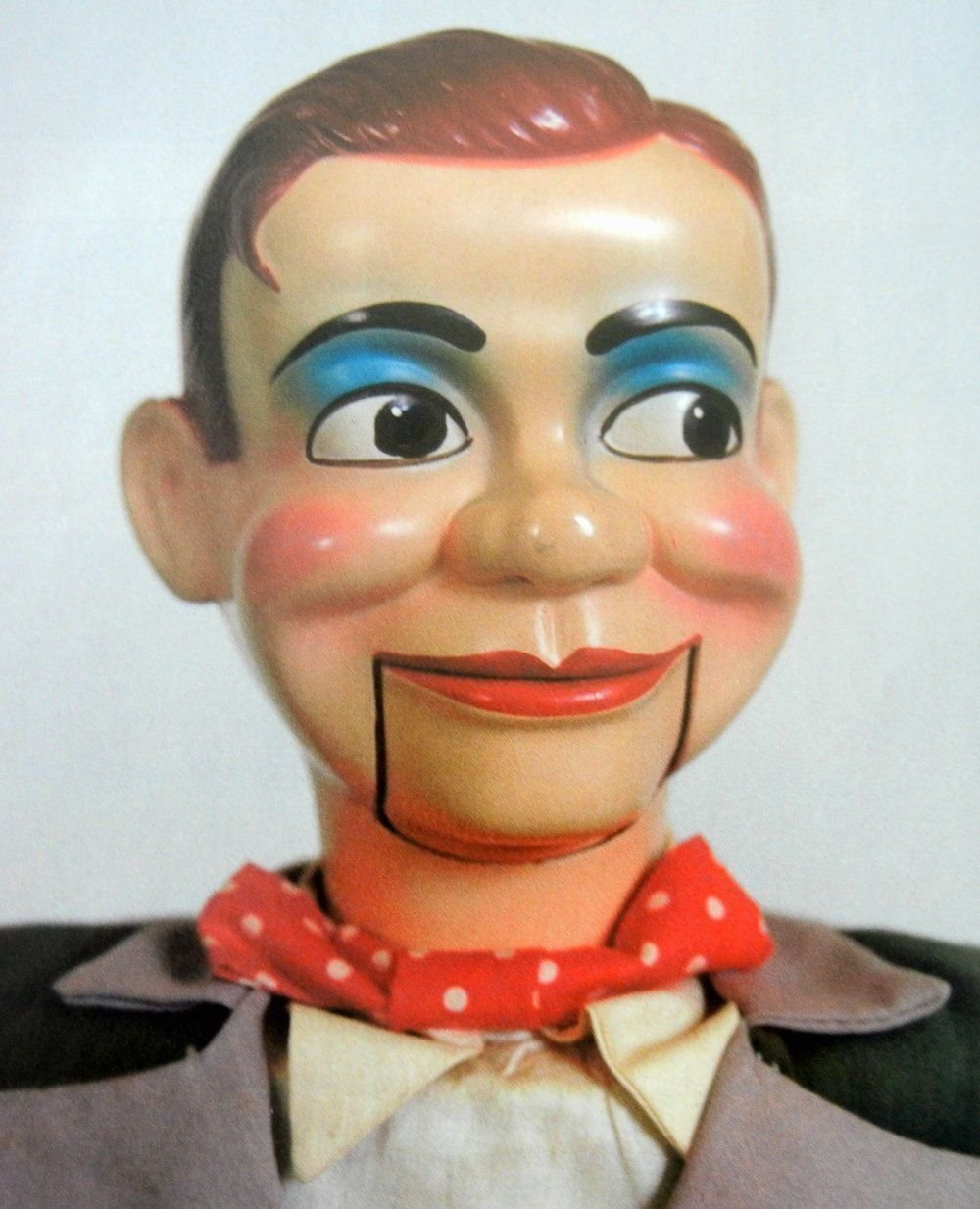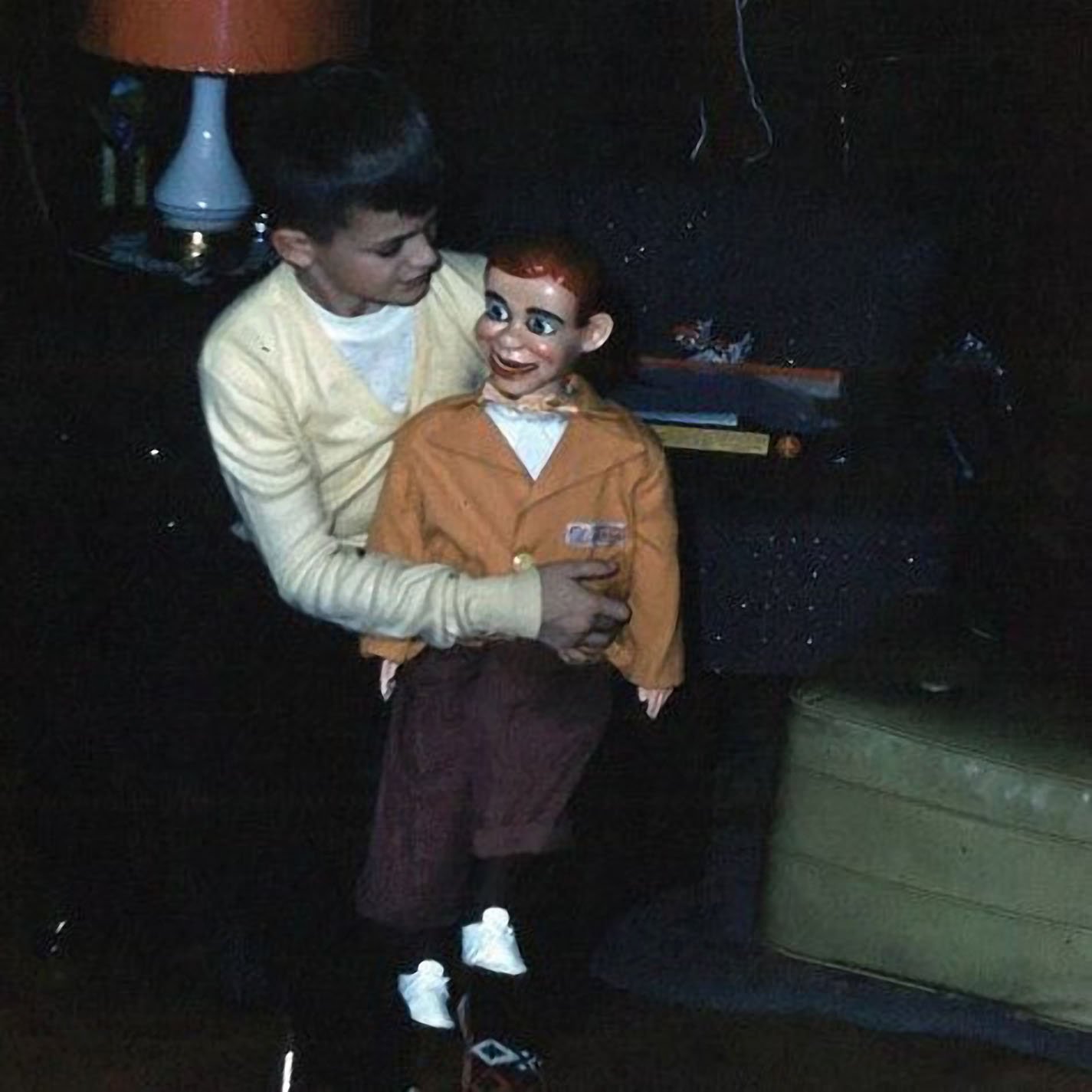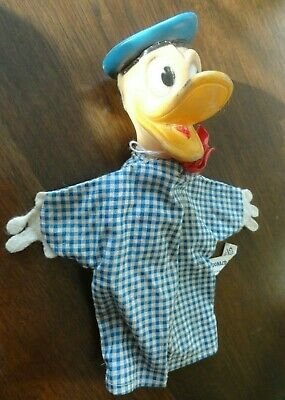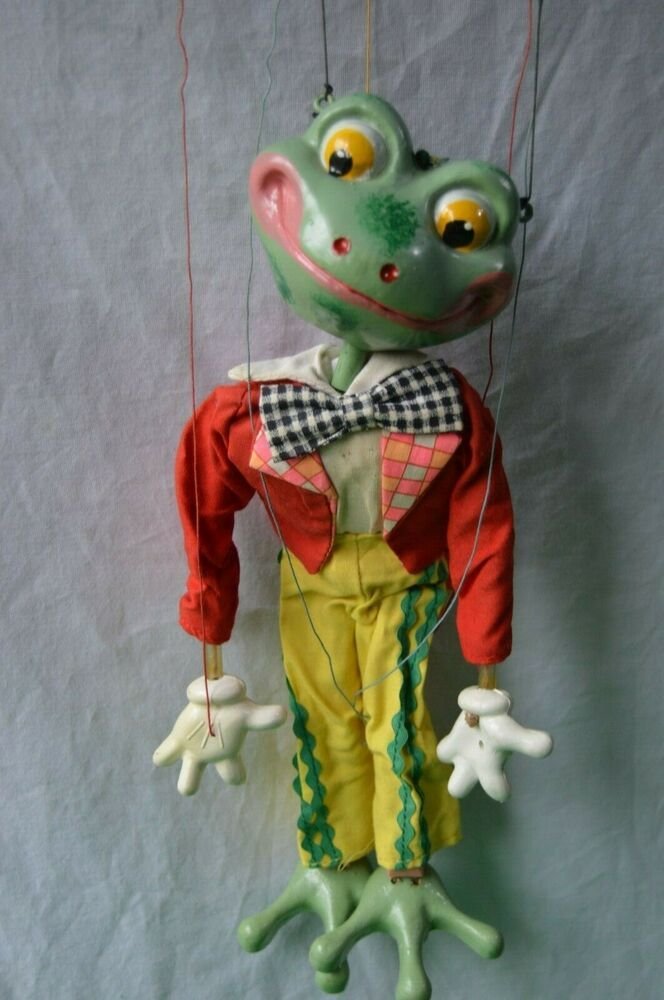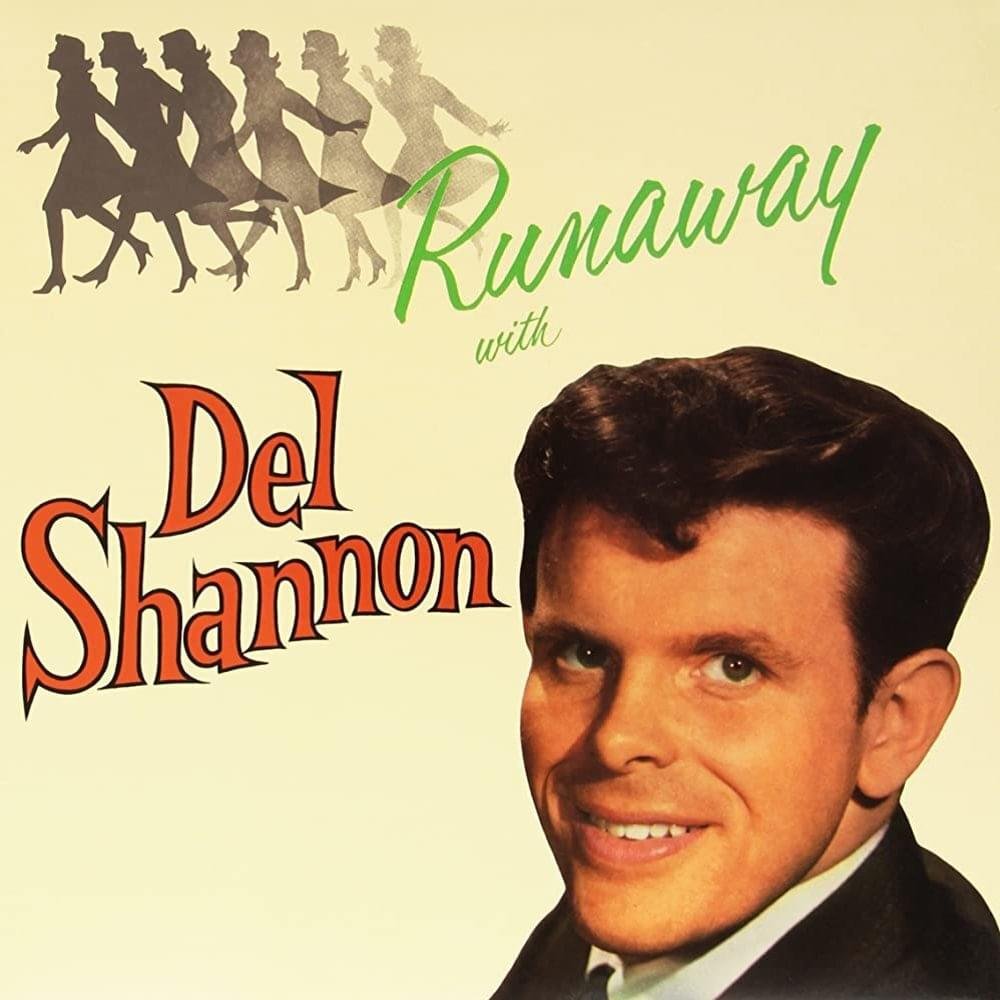Bruce and I both started record collections, and played them on our parents turntables. My very first record was Elvis Presley's self-titled first album. My sister Marcia had grown tired of it, and gave it to me. My father listened to conventional Classical fare from the Romantic period, such as Tchaikovsky, Greig and Elgar. He also liked Dixie flavored or middle-of-the-road jazz, like Al Hirt, or Stan Kenton and the Kirby Stone Four. Bruce briefly played the tuba in the school band.
Music became a necessary staple, like cornflakes or baloney sandwiches. But there were others. I had mentioned an interest in puppets. I had acquired a small collection of hand puppets with cloth bodies and rubber heads. I also had a couple of marionettes, whose strings were forever tangled on their perches. We were in the fourth grade, and I met a fifth grader named Billy Herr, who lived on a dilapidated old farm up the hill from our house, on East 31st Street. He had a younger sister named Patty, and his father worked at Kaiser Aluminum. Billy was a strange and mysterious kid that liked to engage in theatrical fantasies, much like I had done with Marisa in the pear orchards. This often involved Billy disappearing and reappearing amongst the labyrinthine outbuildings and the old gray barn. But what really interested me most about Billy Herr was that he had a Jerry Mahoney ventriloquist figure. I really coveted that dummy, and begged and pleaded with my parents to get me one for Christmas.
A purchase of that sort would normally have been done through Sears catalogue. However, my uncle Kenny Mors worked at a large toy wholesaler, and I suspect that my parents were able to buy it at a discount. In any case, the version that I got was Jerry Mahoney, with movable mouth and separately controlled eyes. Both were operated using strings that ran through a screw eye on the head post. The body was hollow, with an opening in the back for the operator to insert his hand and control the head, mouth and eye movement. I had ordered, again from an ad in the back pages of a comic, a book on ventriloquial techniques. The basic method was to learn to speak without moving the lips, substituting explosive consonants with nasals, e.g. "gottle" rather than "bottle," "nother" rather than "mother." At a certain distance and within the flow of dialogue, the differences are not noticeble. The nasals allow the speaker to maintain immobility in the lips. Since our hearing apparatus is not directional, we rely on visual cues to signal where a sound originates. The animated dummy and his articulated mouth provide this signal; "ginnee a gottle oth gear" sounds like "gimme a bottle of beer" in this circumstance.
A woman contacted my mother and offered to book me into the Veterans and other hospitals, and on local television shows for performances. I was asked to perform at different schools and special events. My father wrote long scripts on yellow legal pads, using gags that he remembered from his days watching vaudeville shows. I would memorize these, and I spent much of my fourth and fifth grade working this performance circuit.
Although my dummy was based on one of Paul Winchell's two famous characters, Jerry Mahoney and Mortimer Snerd, I almost immediately wanted to differentiate my dummy, by altering his looks and providing him a different name. I used enamel paint to change the look of his molded plastic hair, added some freckles, and changed his name to Simon Legree. I soon wanted to have a more elaborate dummy, and did drawings exploring the mechanics of articulated eyebrows, wiggling ears and other realistic additions. In fourth grade I'd started taking the city bus downtown on my own, and I sought out a woman that made mannequins for the department stores. She had a small workshop off an alley near Howard Street. I had my plans for a more sophisticated ventriloquist dummy in hand, and I asked her to help me build it. I spent many subsequent trips discussing the matter with her. In the end she told me that she never had any intention of making the figure, but was amused by the strangeness of this little boy with the big plans and the elaborate schematics. I felt like I had been led on, it was a colossal betrayal. Of course at the time I had no conception of the kind of money required to fabricate such a thing, a sum presumably far beyond my weekly allowance.
The 1950s and early '60s were a time of rigid political ideas and hard social identities. There was a vice principal at Adams Elementary, Mr. Gorton, that did not believe it was fitting for a young man to eschew sports for an interest in ventriloquism or art. He continuously teased and ridiculed me, asking if I was "still playing with dolls." This ignorant taunting eventually took its toll. My interest in puppets and ventriloquism didn't follow me into sixth grade. My mother was disappointed, and when I was twenty-one she told me "You should have kept it up. You could have gone somewhere." I did not disillusion her, although at the time I imagined long lines of professional ventriloquists standing in soup lines and tying cardboard soles to their shoes with string.
At the same time as my foray into ventriloquial performance was playing out (no pun intended,) I had been signed up for Saturday art classes with a teacher named Gayle Anderson. The classes took place on the fourth floor of the Shaw & Borden Building, on Riverside Avenue east of P. M. Jacoy's. Around the same time my older sister Marcia began dating John Thamm, who had a commercial arts studio on the top floor of Shaw & Borden's. I would visit him in his studio, and was introduced to Don Sosha, a sales associate on the first floor, where office furniture, supplies and artist materials were sold. Don would often slip me bags of paint and brushes, pencils, sketchbooks, Speedball pens, etc. at no cost.
There was a large store on East Sprague called Northwest Seed and Insecticide, which catered to the agricultural, gardening and greenhouse communities. They also had a small pet store, and it was from there that John bought Marcia a large Australian kangaroo rat, named simply "Ratly." Marcia was sharing a house with another woman just off 29th. Ratly, who measured about a foot tall, resided in a cage behind the couch. Periodically he would escape from his cage, and I once came by their house to find Marcia's roomate in her slip, standing on the couch because Ratly was on the loose. At other times I would take Ratly, cage and all, outside, where I would charge neighborhood kids a quarter to view him, along with assorted magic tricks from Fun & Fancy. Business was brisk, but Ratly's novelty wore off quickly. After he ate his way inside Marcia's television he was returned to Northwest Seed and Insecticide to try and find his way into some other curious shopper's heart.
Marcia and John eventually married, and had plans to move to California. Immediately prior to moving they came to stay at the Glenrose house. That night they got into a big fight, which I could hear from the bedroom that I shared with my brother in the basement. My father got involved. He had never approved of John, who stormed off that very night. The marriage was annulled, and Marcia moved to California while John moved to New York. I was disappointed in this turn of events. I liked John. He had been a source of inspiration and material benefits. He took me out to lunch where I had my very first slice of pizza, at a place called Gino's on Sprague. I inherited his old American Artist and CA (Communication Arts) magazines. On visits to his apartment, on the north side of Spokane, I would bury myself in his book collection, which included a large volume on Salvador Dali. He had secured me a used easel and drafting table, my very first. Through him I met other older artists, including Don Ealy, who had married one of Marcia's best friends. Don remained a lifelong friend, and my only remaining connection to Spirit Lake during my adult life.
Up until now I had regarded combing my hair as a completely unnecessary waste of time. I showed up at school with my ratty hairdo, which my mother occasionally trimmed. A sixth grade teacher, Ms. Geist, told me that if I would start combing my hair, she would take me for an audition for a Civic Theater play that she had a part in. I agreed, and got the part. The play was "The Desperate Hours," about a group of escaped criminals that holed up in a middle class family's home. I played Ralphie. Ms. Geist played my mother. Margaret (Roseanna) Boyd played my older teenage sister. Later I became friends with Roseanna, when I was teaching at Fort Wright College. Neither of us realized until we were both in our 70s that we had been in a play together as youngsters. My big line was "Mister, you stink!" I memorized my own and everybody else's lines, and cringed when anyone forgot theirs and ad libbed. Walt Hefner, the man who played my father, was the owner of the Starlight Drive-in. He was also the owner of the local skin-flick venues, the El Rey and the Ritz theaters. A few years later Bruce and I would go see Mr. Peek-a-boo's Playmates and other fare at these grindhouses, using fake military ID from Fairchild Air Force base. During the last performance of "The Desperate Hours", in the final scene where the leader of the gang goes storming out of the house to meet a hail of bullets, he ripped the door, which was just canvas stretched over a wooden frame, off its hinges and sent it sailing out into the audience. It lent new meaning to the old troupers' phrase "bringing the house down."
